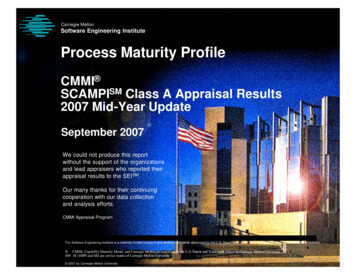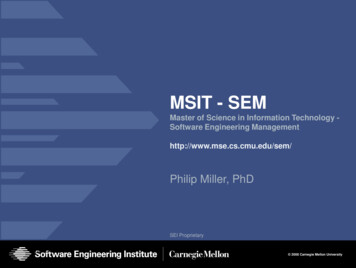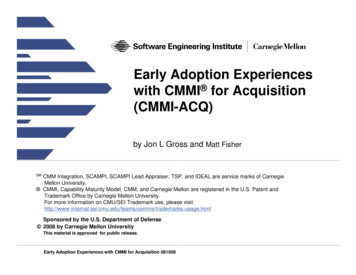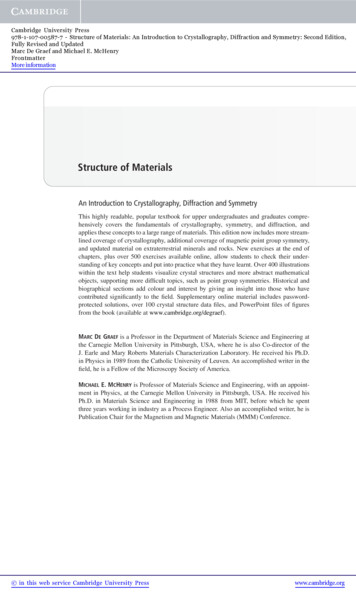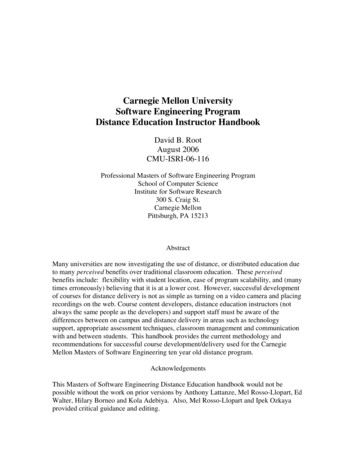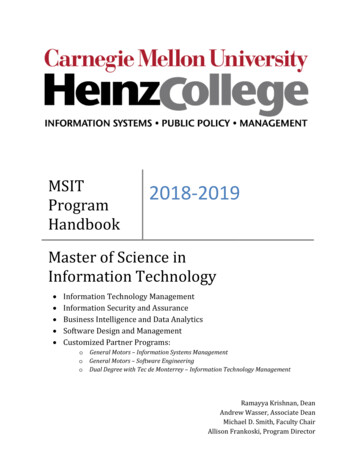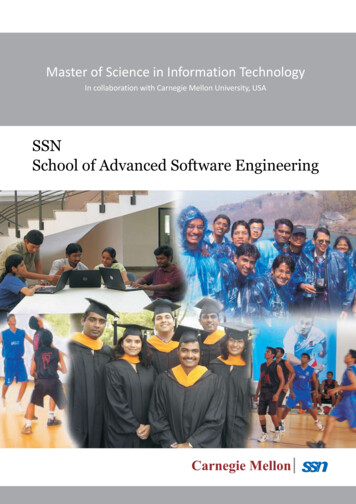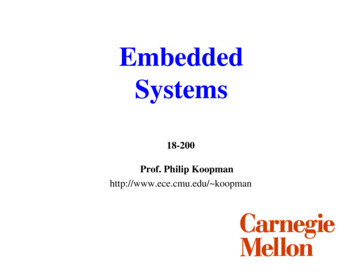
Transcription
EmbeddedSystems18-200Prof. Philip Koopmanhttp://www.ece.cmu.edu/ koopman
Embedded System Computers Inside a Product
Some Embedded Systems Have “Big” Computers3
But, Small Computers Rule The Marketplace Everything here has a computer – but where are the Pentiums?[Smolan]4
[EDN]
How Many CPUs In A Car Seat? Car seat photo fromConvergence 2004 Automotive electronics show6
Car Seat Network (no kidding) Low speed LIN network toconnect seat motion controlnodesThis is a distributedembedded system! CPUFront-back motionSeat tilt motionLumbar supportControl button interfaceCPUCPUCPU7
Myth: Embedded Systems Are Trivial Reality: Winning the game requires shoving 20 pounds into an 3 ouncesack Here’s the design package for a household setback thermostat8
A Customer View Reduced CostIncreased FunctionalityImproved PerformanceIncreased Overall Dependability9
An Engineering View[Leen02]10
An Embedded Control System Designer’s View Measured by: Cost, Time-to-market, Cost, Functionality, Cost & ECTROMECHANICALBACKUP & SAFETYEXTERNALENVIRONMENT11
Common Types of Embedded System Functions Control Laws PID control, other control approaches Fuzzy logic Sequencing logic Finite state machines Switching modes between control laws Signal processing Multimedia data compression Digital filtering Application-specific interfacing Buttons, bells, lights, High-speed I/O Fault response Detection & reconfiguration DiagnosisPW-4000 FADEC(Full Authority DigitalEngine Controller)12
Typical Embedded System Constraints Small Size, Low Weight Hand-held electronics Transportation applications -- weight costs money Low Power Battery power for 8 hours (laptops often last only 2 hours) Limited cooling may limit power even if AC power available Harsh environment Power fluctuations, RF interference, lightning Heat, vibration, shock Water, corrosion, physical abuse Lear Encrypted Remote Entry UnitSafety-critical operation Must function correctly Must not function incorrectly Extreme cost sensitivity .05 adds up over 1,000,000 units13
There Are Many Application AreasPrimary End Product ofEmbedded Systems ProgrammingSubscribers (Dec. 1%Industrial Control15%Automotive/TransportationSystems & Equipment5%Computers/PeripheralsOffice Automation13%Consumer Electronics/Entertainment/Multimedia6%Medical ElectronicEquipment6%Aerospace/Space Electronics6%Electronic Instruments/ATE/ Design &Test 0%14
Various Embedded Computing Areas – 1 Small embedded controllers (e.g., thermostats) 8-bit CPUs dominate, simple or no operating system Control systems (e.g., automotive engine control) Often use DSP (Digital Signal Processing) chip for control computations Distributed embedded control (e.g., cars, elevators, factory automation) Mixture of large and small nodes on a real-time embedded network System on chip (e.g., consumer electronics, set-top boxes) ASIC design tailored to application area Network equipment (e.g., network switches; telephone switches) Emphasis on data movement/packet flow Critical systems (e.g., pacemakers, automatic trains) Safety & mission critical computing15
Various Embedded Computing Areas – 2 Signal processing (e.g., face recognition) Often use DSP chips for vision, audio, or other signal processing Robotics (e.g., autonomous vehicles) Uses various types of embedded computing (especially vision and control) Computer peripherals Disk drives, keyboards, laser printers, etc. Wireless systems Wireless network-connected “sensor networks” and “motes” to gather andreport information Embedded PCs Palmtop and small form factor PCs embedded into equipment Command and control Often huge military systems and “systems of systems” (e.g., a fleet of warshipswith interconnected computers)16
Trend: Internet-connected embedded systems17
Trend: External Connectivity Safety critical subsystems will be connected to external networks(directly or indirectly) This is going to lead to security issues[Airbus 2004] A-380 scheduled to enter service in 200618
Z Wargo & Chas, 2003, proposed Airbus A-380 architecture19
Trend: Desktop Software In Embedded Systems Highly dependable software is often required But desktop systems aren’t designed to provide that!7/28/98:“Windows NT Cripples US NavyCruiser” Diebold voting machine problems Electronic voting machines booting to windows instead of votes http://catless.ncl.ac.uk/Risks/23.27.html#subj8.1 Automated teller machine crashes Windows error messages At Carnegie Mellon, someone got an ATM to run media player20
http://www.coed.org/photodb/folder.tcl?folder id 3334"When ATMs go bad by Carla Geisser“, March 18, 2004(See also: http://midnightspaghetti.com/newsDiebold.php)21
X-by-Wire As Topic Motivation X-by-Wire is perhaps the ultimate automotive computer technology All embedded computers in automobile will probably interface to it Has the most stringent requirements[Heiner]22
Why Take Embedded Computing Courses? Optimizing cost, size & speed Understanding hardware lets you do more functions with less cost– Sometimes you can’t spend more than 1 on a CPU, but it still has to fit everything Getting good performance requires understanding some hardware details Some hardware doesn’t have a lot of support software Sometimes there is no good I/O support in high level languages Sometimes assembly language is the only way to get good enough code Very often, debugging requires some understanding of hardware Some skills are almost impossible to learn on your own E.g., ultra-dependable system design for safety critical systemshttp://www.pjrc.com/tech/8051/board5/dev5 big.jpg23
ECE Embedded Course Sequence: Pre-reqs: 15-213 Introduction to Computer Systems 18-230 Fundamentals of Computer Engineering 18-349 Embedded Real-Time Systems Single-CPU embedded systems 18-549 Distributed Embedded Systems Multiple CPUs on an embedded network; critical systems; system engineering 18-749 Fault-Tolerant Distributed Systems Enterprise systems with fault tolerant middleware 18-849 Dependable Embedded Systems Deep coverage of dependability & safety critical system research papers Many other relevant specialty and related courses ControlsRoboticsSoftware engineering 24
18-349 Introduction To Embedded Systems Junior-level course with significant project content Course areas: Low level system/software– Combining C & Assembly language– Software profiling and optimization– Memory management Hardware interfacing––––I/OBuffering and DMASerial communicationsTimers & Interrupts Real time operating systems– Resource management– Rate monotonic scheduling– Loaders, object files Interacting with the outside world– Basics of feedback control and signal processing– A/D and D/A conversion25
18-549 Distributed Embedded Systems Capstone design course Semester-long project with representative embedded system design cycle:Requirements / design / networking / implementation / test / fault recovery Course areas: System Engineering– Requirements, design, verification/validation, certification, management-lite System Architecture– Modeling/Abstraction, Design Methodology, a little UML, Business Issues Embedded Systems– Design Issues, scheduling, time, distributed implementations, performance Embedded Networks– Protocol mechanisms, real-time performance, CAN, FlexRay, embedded Internet Critical Systems– Analysis Techniques, software safety, certification, ethics, testing, gracefuldegradation Case Studies– Elevator as capstone design project– Guest speakers and other discussions as available26
Small embedded controllers (e.g., thermostats) 8-bit CPUs dominate, simple or no operating system Control systems (e.g., automotive engine control) Often use DSP (Digital Signal Processing) chip for control computations Distributed embedded
